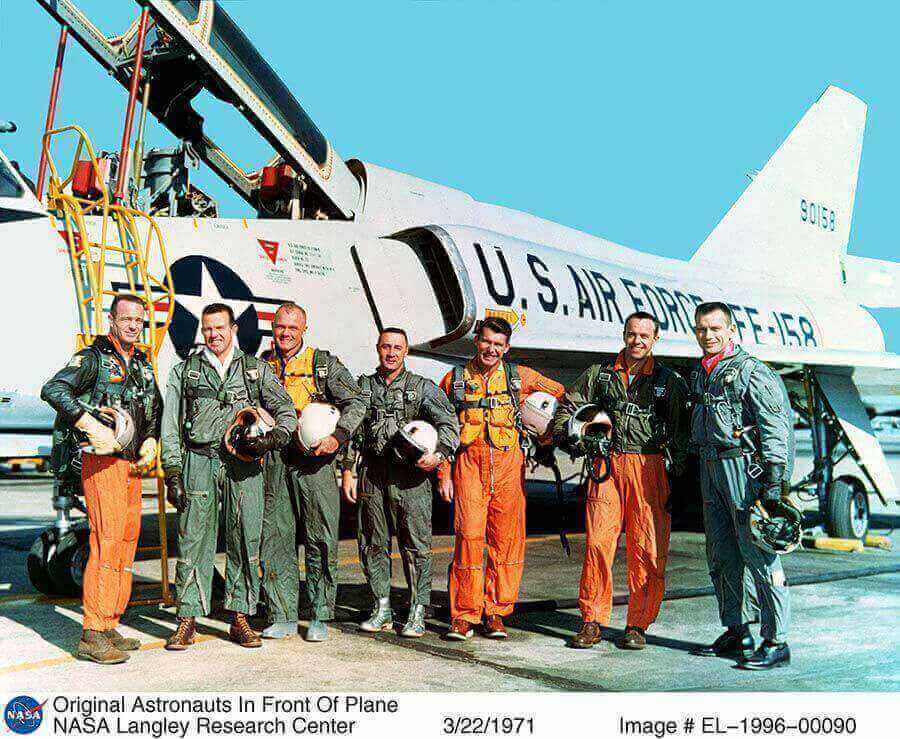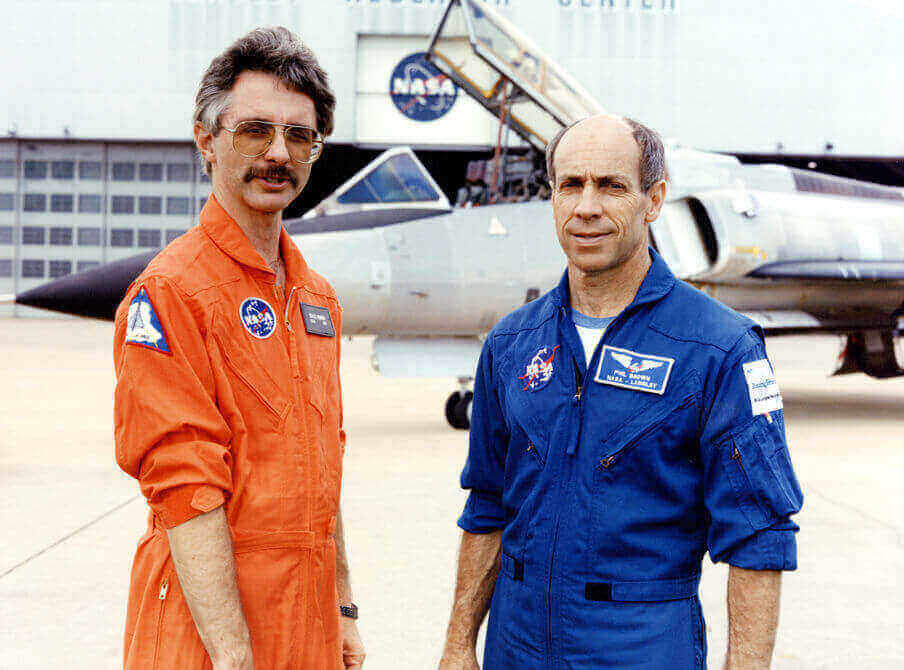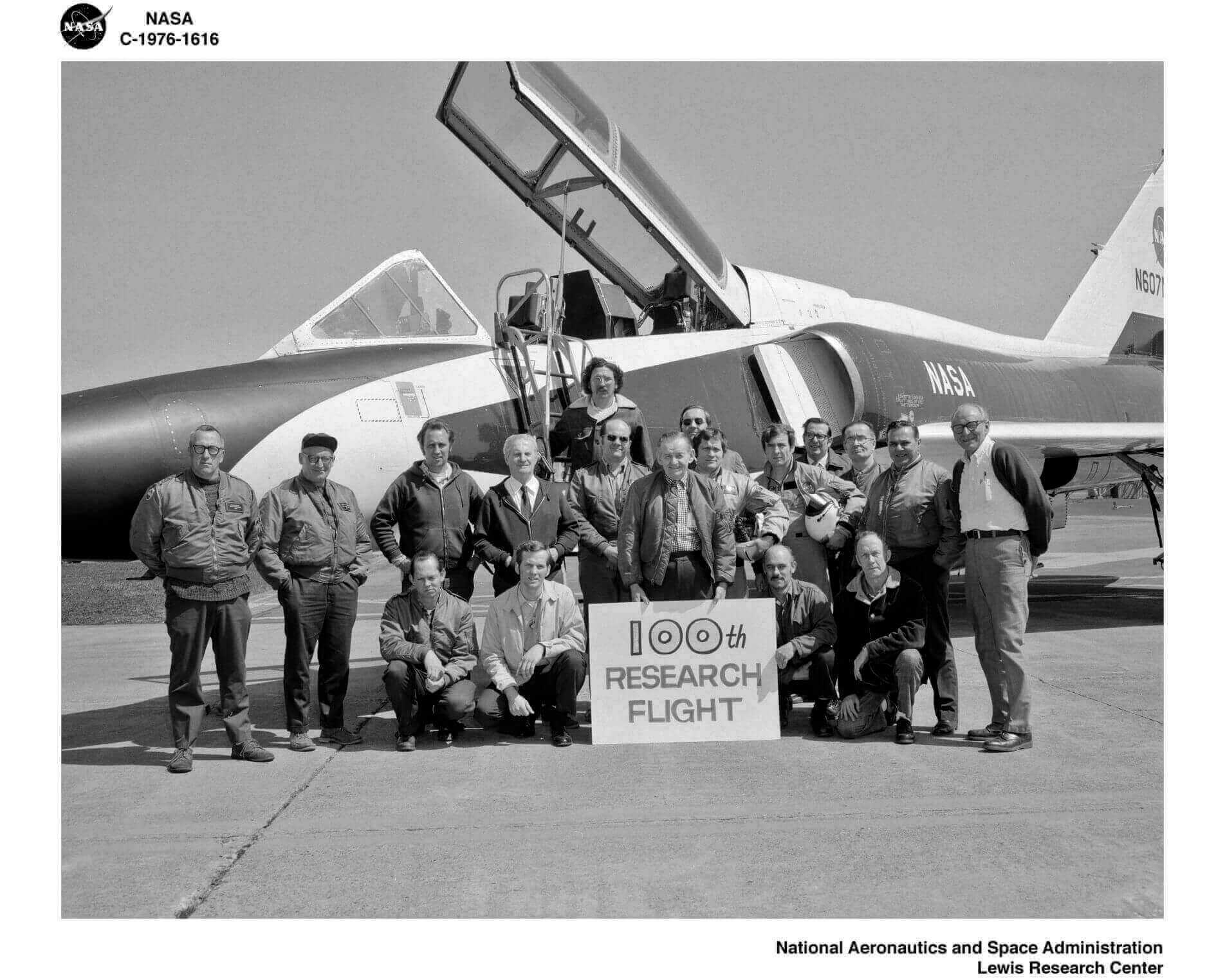Lewis [Glenn] Research Center
Dryden (Armstrong) Flight Research Center
Langley Research Center
NASA and the F-106 had a long relationship together conducting research, test and development for more than 30 years out of the Langley Research Center, Hampton VA, Lewis Research Center, Clevland OH renamed John H. Glenn Research Center 1 Mar 1999 and the Dryden Flight Research Center, Edwards AFB, CA renamed the NASA Neil A. Armstrong Flight Research Center (AFRC) in March 2014.
Two F-106B aircraft were assigned to NASA as part of it's research projects:
F-106B 57-2516 as NASA NF-106B using serial numbers N616NA and N816NA
F-106B 57-2507 as NASA NF-106B using serial numbers N607NA and N607NM
Each NASA Research Center had it's own Aircraft Tail Number Assignment Designation code for the aircraft assigned at the time. This was the 'lead number' for their assigned aircraft tail number. However, it is expected that the aircraft may have flown with different Centers with an actual number change. While the aircraft did spend a lot of time at Langley Research Center, a NASA tail number of 516 has not been found (5 being Langley).
No. '5' is assigned to aircraft at the Langley Research Center, Hampton VA.
No. '6' is assigned to aircraft at the Lewis Research Center, Cleveland OH (renamed John H. Glenn Research Center 1 Mar 1999).
No. '8' is assigned to aircraft at the Dryden Flight Research Center, Edwards AFB, CA.

[From Left] Lt. M. Scott Carpenter, Capt. Gordon Cooper, Col. John H. Glenn Jr, Capt. Virgil "Gus" Grissom, Lt. Cdr. Walter Schirra, Lt. Cdr. Alan B. Shepard Jr., Capt. Donald K. "Deke" Slayton [Source]
The seven original Mercury Astronauts standing in front of F-106B 59-0158 Jan 20, 1961 - NOT 1971. While familiarizing the astronauts with the Mercury set-up, Langley employees helped them to specialize in technical areas crucial to the overall success of Project Mercury. Langley people guided and monitored astronaut activities through the many spaceflight simulators and other training devices built at the Center expressly for the manned space program.
Photo Date 1971 in Error!
The photo is printed 1971, but as Charlie Gindhart pointed out on 16 April 2002 to me via email, 59-0158 was not at Langley, Gus Grissom was killed on 27 January 1967 along with fellow astronauts Ed White and Roger Chaffee, Glenn, Schirra, Cooper and Carpenter had already left NASA by 1971, buzz numbers were not used in 1971. So Charlie sent an e-mail to the Langley Research Center. The real date was found to be 1961.
Alicia V. Tarrant, NASA JSC, writes back about the photo date error: "My JSC contact has indeed confirmed that S61-01250 (aka L71-2971 and EL-1996-00090) was photographed on 01/20/61. It was originally photographed here at Langley by JSC people and the photo was taken back to Houston. We received a copy negative from them in 1971 and I guess that is where the 1971 date came from. My thanks to Mr. Gindhart for finding the error so that I can correct it. I will be editing STILAS and LISAR soon. The new caption will read: 'The original seven Mercury astronauts standing beside a Convair F106-B aircraft. They are, left to right, M. Scott Carpenter, L. Gordon Cooper Jr., John H. Glenn Jr., Virgil I. Grissom, Walter M. Schirra Jr., Alan B. Shepard Jr., and Donald K. Slayton. Photographed on 01/21/1961 at Langley Air Force Base.' Thanks, Alicia V. Tarrant, NASA JSC"
So, the center will be changing the photo caption to reflect the real date so any photos you see with 1961 was a direct result of Charles' actions.

About the photo: Research Pilot Phil Brown and NASA Engineer Bruce Fisher in front of NF-106B N816NA during its time in the Vortex Flap Research project
NASA used F-106B 57-2516 for 30 years designated at different times as NASA 616 and 816. It served as the test vehicle for a series of important Air Force and NASA research projects and was transferred to the Langley Research Center in January 1979. While at Langley it was associated with buildings 7 x 10-Foot High-Speed Tunnel, the Full-Scale Tunnel, and the Hangar. It was retired in May 1991 making it the last known manned F-106 passing from active service. During it's NASA time it was utilized in projects for:
- Research and Development Testing for U.S. Air Force
- Supersonic Transport Program
- Storm Hazards Research
- Vortex Flap Flight Experiment at Langley Research Center
- Off-Surface Flow Visualization System
- Landing Systems
It now flies proudly hanging from the ceiling on display at the Virginia Air and Space Museum
NF-106B NASA N816NA Retirement Ceremony, May 17, 1991 [NASA Langley film #6543]. This video includes remarks by program directors Joseph Chambers, Richard Whitcomb, Fred Wilcox, and Norman Crabill.
During its 30 years of service with NASA 57-2516 served as the test vehicle for a series of important Air Force and NASA research projects. This historic aircraft is now on Static Display at the Virginia Air and Space Center, Hampton, VA.
F-106B 57-2516, NASA NF-106B N616NA and N816NA: During the 30 years of service at NASA, the F-106B (NASA 616/816) served as the test vehicle for a series of important Air Force and NASA research projects. The aircraft was utilized for: Research and development testing for the U.S. Air Force, Research in support of the U.S. Supersonic Transport Program of the 1970's at NASA Glenn, Research in the Storm Hazards Program and the Vortex Flap Program at NASA Langley. It was used in NASA projects in several different NASA centers and under 2 different NASA identification numbers during its career. As NF-106B N616NA (616) it was assigned to the Lewis Research Center, Cleveland OH from 1966-1979. When the Lewis research programs were terminated the aircraft, being a high performance aircraft, was assigned to the Dryden Flight Research Center, Edwards AFB, CA in 1979. The tail number was renumbered to N816NA (816) although the aircraft didn't spend any actual time at Dryden. Instead it was loaned out to projects at theLangley Research Center, Hampton VA. and although the Langley Center uses the number '5' for its aircraft, since the aircraft was actualy assigned to Dryden it retained it's N816NA tail number, never getting a 516 number. In 30-plus years of service F-106B 57-2516 as NASA 616/816 flew in support of U.S. Air Force research and development testing 9 years, assisted research on the U.S. supersonic transport program of the 1970s at NASA's Lewis Research Center for 13 years and conducted storm hazards and vortex flap programs at Langley for 12 years. The second seat of this B model allowed flight test engineers to ride along, operating test equipment and making observations.
The aircraft was the last known 'piloted' F-106 Delta Dart to ever fly.
HISTORIC NASA AIRCRAFT TO STAR IN NEW MUSEUM
Donald G. James
NASA Headquarters, Washington, D.C.
May 13, 1991
H. Keith Henry Langley Resesrch Center, Hampton, Va.
It's been blasted by more than 700 lightning strikes, simulated a supersonic transport and tested a wing design for future fighters. Now "NASA 816" -- a specially modified Convair F-106B -- has retired after more than 3 decades of flight research. NASA 816 made its last flight on April 30. It was the last known piloted Convair F-106 still flying.
In a May 17 ceremony at Langley Research Center, Hampton, Va., NASA 816 will be symbolically transferred to the new 110,000 square-foot Virginia Air & Space Center, Hampton. The aircraft will move to its new home this summer and go on display with other civilian and military aircraft in time for the center's grand opening in the spring of 1992.
In 30-plus years of service, NASA 816 flew in support of U.S. Air Force research and development testing (9 years), assisted research on the U.S. supersonic transport program of the 1970s at NASA's Lewis Research Center, Cleveland (13 years) and conducted storm hazards and vortex flap programs at Langley (12 years).
The F-106 design has special significance for Langley Research Center. Dr. Richard Whitcomb, a distinguished Langley retiree, played a key role in developing the "area ruled" fuselage used on the Convair F-106 and its predecessor, the F-102A. The Coke-bottle-like shape was a revolutionary advance in aircraft design that made supersonic speed in level flight practical. An F-106 set a world speed record of 1,525 mph in 1959 and still holds the record as the fastest single-engine turbojet-powered airplane. NASA 816 is a two-seat F-106B. The second seat allowed flight test engineers to ride along, operating test equipment and making observations.
For the Air Force, the aircraft tested new modifications before the modifications were incorporated in the F-106 fighter fleet. It served at Edwards, McClellan, Tyndall and Holloman Air Force Bases, Geiger Field, Spokane, Wash. and Convair/General Dynamics, Fort Worth.
The F-106B was a one-of-a-kind workhorse at Lewis. Under its left wing, it carried an extra engine to study how the propulsion system interacts with the highly-swept wing of a supersonic airplane. Under its right wing was a comparison engine. In more than 300 flights from 1966 to 1979, researchers collected valuable information that contributed to the understanding of supersonic aerodynamics and engine noise.
At Langley, NASA 816 was "lightning hardened" and purposely flown into thunderstorms to be struck by lightning. The storm hazards program learned much about the fundamental nature of in- flight lightning that will benefit designers of future aircraft.
Today's aircraft are relatively immune to the effects of lightning. But future aircraft may be more susceptible as a result of increased use of nonconductive composite materials in their structure. They also may have more lightning-sensitive electronic control and display systems.
For its next series of flights, NASA 816's wings were reshaped for best aerodynamic performance at times when a supersonic airplane must fly at subsonic speeds. These times can be critical for a military airplane in aerial combat or for a supersonic transport attempting an efficient, relatively quiet takeoff. The NASA-developed modification, a thin downward pointing flap added to the wing leading edge, greatly reduced drag and proved the "vortex flap" idea.
NASA 816 was manufactured in 1958 by the Convair Division of General Dynamics. In all, 277 F-106A and 63 F-106B "Delta Dart" airplanes were built at a cost of about $5 million each. Each F-106 was powered by a single Pratt and Whitney J75-P-17 turbojet engine. Developed as a Mach-2 interceptor, its mission was to intercept unidentified aircraft as they entered U.S. airspace. The F-106 served with the USAF Command, Tactical Air Command and the Air National Guard.
The Air Force has retired the F-106, once called the "ultimate interceptor," from active squadron service after a long and distinguished career dating from the late 1950s. Remaining aircraft fly as drone targets during air-to-air missile training for the current generation of fighter aircraft.
- end -

About the photo: Research team members with NF-106B 57-2507 N607NA following its 100th research flight [NASA Photo, NASA Identifier: C-1976-1616]
NASA used F-106B 57-2507 at the Langley Research Center in several different research projects to include:
- Upper Atmosphere Particulate Sampling Research
- Ocean Color Scanner System
- And for its final mission it was used to create the NASA Wind Tunnel model in 1988 for Vortex Flap and In-flight Visualization
Research where NASA cut it in half lengthwise so that the left hand side could be mounted in the wind tunnel to test the vortex flap used on F-106B 57-2516 NASA N816NA. Tom Luck writes on 4 Mar 2014: "I worked on a number of jobs at NASA Langley's full scale wind tunnel and they jokingly referred to this 'Cut in Half' F-106 as the F-53, which is 1/2 of 106".
Photo Galleries
Upper Atmosphere Particulate Sampling
Ocean Color Scanner System
NASA Chase Plane